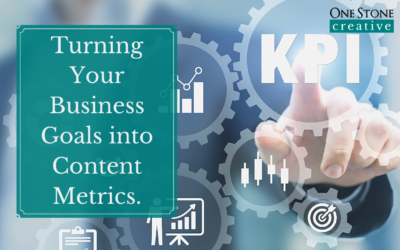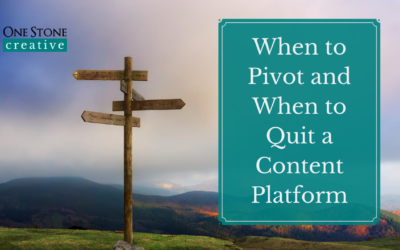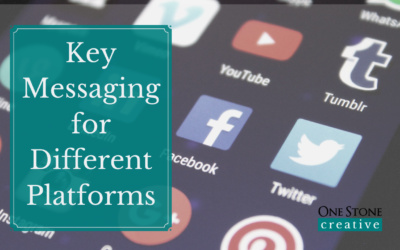One of the chief goals of any content marketing program is conversions. Creators want their content to convert users of that content into customers for their business.
When you have a piece of content that converts well, it’s essentially a goose giving you golden eggs, helping your business slowly but surely grow in value.
If you’re familiar with the fable, the farmer is impatient with the slow rate of egg production and kills his goose hoping to get all the eggs at once. Plainly he was unfamiliar with the inner workings of poultry because he was shocked when he didn’t find the creature stuffed to the brim with golden eggs.
And that’s not dissimilar to what happens to content marketers who create excellent content that really ought to convert beautifully that just… doesn’t. They get understandably frustrated and often give up on platforms altogether.
Certainly, there are times when it’s appropriate to pivot or quit a content platform, but more often we’re looking at content creators being angry that their golden goose isn’t providing bacon.
Different platforms convert in different ways, and hoping for a podcast to have the same kind of conversions that a video does is a recipe for disappointment.
The conversion goal has to match the content platform and the different types of conversion that are possible need to be measured on their own to determine what kind of value they bring.
Let’s get into that.
What is a Content Conversion anyway?
If you’re familiar with the internet marketing world, that will be pretty obvious, but if you’re not, let’s get clear on what a conversion is when we’re talking about content.
A conversion is when a consumer of your content takes an action of some kind and goes from being one thing to another in their relationship to you. Click To Tweet
For our purposes, a conversion is when a consumer of your content takes an action of some kind and goes from being one thing to another in their relationship to you.
Typically, we’re talking about actions like clicking a link, joining an email list, buying a product, or booking a call, but it can also be something like commenting on a post, sharing on social media, or leaving a review.
You want to have a good idea of the rates of conversion you have for the different parts of your content marketing mix, so you can estimate the effectiveness of your different content campaigns.
(When we’re talking about the rate of conversion, it’s the percentage of the total audience to the people who take the action you’re measuring.)
And of course, we can’t manage what we don’t measure! Because you’ve set good goals for your content, conversions (of varying types) will be one of the main metrics that you track to see if you’re meeting those goals.
Not all calls to action or digital content platforms are created equal. Technically, as an adult human with free will and an internet connection, you could use any kind of call to action on any kind of platform you want. However, it makes a lot more sense to think about which kinds of conversions are going to be the easiest to obtain on the type of platform you’re using.
Not all platforms are created equal when it comes to conversions. Click To Tweet
Let’s go through each of the different platforms and talk about which kinds of conversions are the most likely, and which provide other, less direct benefits that can really add value over the long term.
Types of Conversions
Let’s quickly run down the different types of conversions you might want to measure. Of course, you can dig down into any of these, and the exact mix of metrics that matter for your content goals will be unique to your business – and might even change over time!
This should be enough to get started.
Links Clicks. A link click is just what it says on the package – when someone sees a URL and clicks on to the destination. When we’re talking about audio-based content and there may not be a link to click (or a link that someone can easily click at the moment) but it may be a URL visit where they go to a new page later on.
Social Shares. If your media is being shared on Facebook, Twitter, LinkedIn, Instagram – any of the social platforms – that’s a social share. This is a good one to track because a lot of your audience is going to be on social sites talking about the things you’re an expert in. It’s always good to know how well your content is doing on social platforms.
Social Engagements. A social engagement is a comment or response to something that you posted on social media. It might be an answer to a question, a comment on your ideas, a request for more information, general praise, or a stream of vitriol. You win some; you lose some.
Email Opt-Ins. Email Opt-Ins are one of the highest value conversions you can get. When someone opts-in to your list, you have the opportunity to connect with them again and again, moving them from one level of your funnel to another as your relationship builds. All things being equal – this is a great conversion to optimize for.
Calls Booked. Sometimes you just want new clients! If that’s the case, then a metric you might want to work on is getting more calls booked with you or your sales team. This is a big ask, and you’ll probably want to work up to that through a series of smaller, easier conversions like link clicks and social engagements.
Backlinks. Backlinks are when someone links to your content on their site. This is awesome for getting more traffic and also for building your SEO over time. It’s a ‘vote’ by one content creator for another, and that’s an awesome thing.
Purchases. The end goal of our business activities. Over time, all of your conversions should be leading to purchases of your products or services. Like with Calls Booked, you probably won’t get a sale the same day someone hears your podcast for the first time, but eventually, a certain portion of your audience should be buying what you’re selling.
Video Conversions
Video is one of the gold star performers for conversions of many different types. It’s easy for people to share the video because they’re watching it usually on a device that makes sharing really easy. It’s also great for getting people to click links to other pieces of content. Because it’s such a relational format, making bigger asks like “book a call” also has a higher probability of success.
One of the coolest conversions to encourage on YouTube is binge-watching your playlists. You can create whole libraries of content that cover certain topics or teach different things. A well-constructed playlist is really easy to consume, and that’s a wonderful opportunity to provide a lot of value for your community.
Best types of conversions:
- Link Clicks
- Social Shares
- Comments / Engagement
All right – let’s move on to podcasts.
Podcast Conversions
Here’s the thing with podcasts.
The reality is…they don’t convert hugely.
People usually listen to podcasts on their phones while they’re doing something else. This is wonderful from the standpoint of being a part of your listener’s life but pretty miserable in terms of people being able to follow calls to action.
If you’re listening to a show on your commute, taking advantage of even a great call to action at that exact moment is illegal in many jurisdictions, and likely to cause multiple vehicular fatalities.
For a podcast conversion to happen someone either needs to be in a place and time where they CAN take the next action, or they REMEMBER to take it later.
That just doesn’t happen terribly often because of math.
On the other hand, people tend to have a very good recall about what they learn on podcasts. So even if your listeners don’t download your freebie, they may remember your name and some advice you gave the next time they are talking to a friend.
Top podcast conversions:
- Link Clicks (In this case: URL visits!)
- Backlinks
You’ll see higher conversions when you’re promoting your podcast than when people are listening to it on their own. Then you can look for:
- Social Shares
- Ratings and Reviews
- Engagement
- Link Clicks
(Something to keep in mind, however, is that it’s not just your listeners you can convert with your podcasts. Guests and promotional partners are going to have a much more 1:1 relationship with you, and you’ll have more touchpoints to make sales or other requests.)
Now for blogging – in terms of conversion, blogging couldn’t be more different from podcasting.
Blog Post Conversions
When people are reading, they are directly engaging with their phone or computer and are in a position to click a link, watch a video, opt-in to an offer, share a tweet, or buy something.
When a content path (or series of conversions you want people to make) is well-designed, there is a flow for new, returning, and regular readers to follow that gets them into marketing funnels, helps them achieve their own goals, and supports them once they’ve become a client.
A blog can very much become a hub of all your other content, pulling people in, and sending them off in other directions that will serve their needs best, all within your own environment.
Blog conversions are also some of the easiest to track! With a few plugins on your WordPress site and a good system for tracking page visits and link clicks, you’re awash with data. You can use that to easily see what’s working and what isn’t, and make necessary changes.
Best Blog Post Conversions:
- Email Opt-Ins
- Comments
- Link Clicks
- Backlinks
All right – let’s talk about the last multi-media platform we’re covering today. I’m skipping courses and books because, while you CAN get different kinds of conversions from them – more often than not, you’re going to be trying to get people to convert TO a course and book rather than FROM them – especially at the lower levels of conversions. Using your courses and books to make higher-level sales and have more involved conversations with your clients is a topic for another day.
Conversions from Live Streaming
Conversions on live streams can be really high! You’ve essentially got your live stream viewers in a digital room with you. Granted, it’s a room with many, many distractions, not the LEAST of which are videos of cats wearing funny hats. But if you can get some good back and forth engagement going, which is a type of conversion in and of itself, then you’re in a position to make an offer that people get excited about and be on hand to answer potential questions.
This is a high-converting environment – but it has its own downfalls. It’s live – so you really only get that conversion opportunity while you’re actually running it.
The recording of a live stream can also convert, but it would be wise to moderate your expectations about that. The special energy of two-way conversion doesn’t happen in a recording, so while you might get shares and link clicks, it probably won’t be quite as many as when you were doing it live.
Best Conversions for live streaming:
- Link Clicks
- Calls Books
- Sales
- Social Shares
- Comments
There we have it – Content Conversion on the different platforms. All of this can be a lot to take on at one time, so if you’re looking for a place to start, choose the platform that you like the most, and see the most engagement on. Track what your conversions currently are, and set a goal for how you want them to improve!
About the Author

Megan Dougherty is the Co-Founder of One Stone Creative. She has been a digital marketer for over a decade, with a strong focus on digital course creation, content marketing and multi-media content production. As the co-founder, she takes pride in high-quality, on-time work and helping people get their messages to the people who need to hear them. She likes spreadsheets, deadlines and creating online experiences that are good for both the creators and the end-users. She hates jumping out of airplanes, mushrooms, and hyberbolic language in messaging. When not helping to produce podcasts courses and videos, she bakes pies and watches Star Trek. (Janeway forever.)



